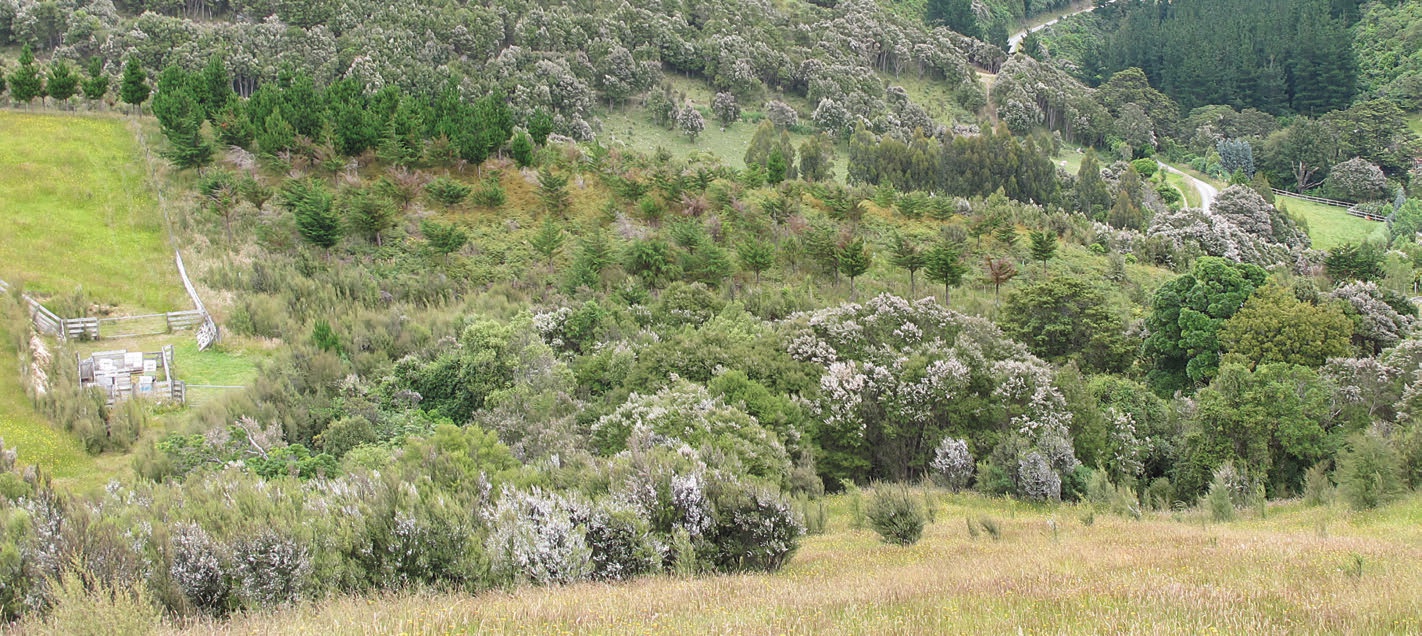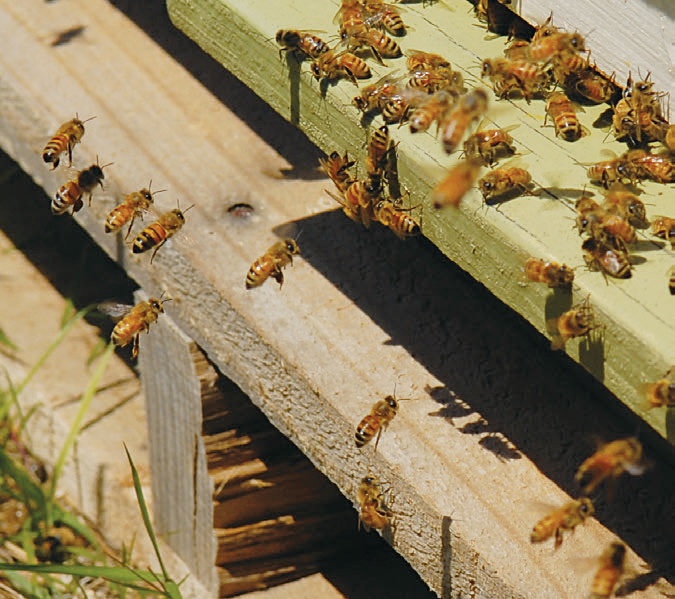Growing manuka for farm foresters and other small-scale foresters
Julian Bateson, New Zealand Tree Grower May 2014.
Manuka is an excellent coloniser of bare ground. As a result, for many years it was thought of as a weed on agricultural land as the plants started the first part of the process of succession, taking bare grassland eventually to full mature forest. Currently manuka has some economic uses, as a source of nectar for bees to produce manuka honey, as firewood and for the manuka oil from the leaves.
A one-day manuka conference was held in Masterton late in February organised, in conjunction with the NZFFA, by Stuart Orme. The attendance was a pleasantly surprising number of over 130 people from many parts of the country. Some were members of the NZFFA but many were not. However at the very beginning the question was asked − Is growing manuka for farm foresters?
What we heard
Following the introductions, a distinctive array of speakers was led by Professor Peter Molan from Waikato University. Peter was the person who around 30 years ago decided to look into the benefits of manuka honey, compared with others, as it was reputed to be the best there is for treating infections.
Honey has been used for thousands of years on wounds as an antibiotic to help healing. This is mainly due to the presence of hydrogen peroxide produced from an enzyme used by bees. Honey applied on wounds to help the healing process fell out of use when penicillin and other antibiotics were developed.
Manuka honey is particularly special because of the presence of methylglyoxal as well as hydrogen peroxide. This methylglyoxal, often referred to as mga, is a very powerful antibiotic and does not lose its potency as time passes in the way that hydrogen peroxide does. We were shown a number of gory photographs of wounds before and after treatment with manuka honey, and it seems to work almost like magic. Wound dressings using manuka honey are now in use in hospitals around the world. Peter warned us about the labels showing the activity rating of other honey which could show high numbers but only due to the hydrogen peroxide content
You may now be asking what has all this to do with farm forestry. Simeon Smaill from Scion, who was the next speaker, came up with some of the answers. His research compares the management required for growing radiata pine with that for growing manuka for honey. Both have a rotation period of around 25 to 30 years, with manuka gradually being out-competed by kanuka and other native vegetation. Both radiata pine and manuka work best on marginal hill land and also act as erosion control while producing a crop. On the other hand, radiata pine is well understood after decades of intensive research but there are a number of unknowns with regard to planted manuka, such as whether it needs thinning or if it needs fertiliser. If it does, will this change the nectar in any way?

Income of $500 per hive
Growing manuka from planted stock, then adding bees, is what Victor Goldsmith of the Miere Coalition spoke about next. He decided to work out a financial model for bee keeping and growing manuka while working closely with other land owners. He suggested that, based on an average of 23 kilograms per hive of manuka honey, each hive gives a gross income of around $500 a year. The cost of beekeeping is about half this, so a net $250 per hive should be expected.
The landowner needs work out the best option for income from beehives. It can be a royalty of between 10 per cent and 20 per cent of the gross income, or it can be a rent per hive of perhaps $50 a year. What this means in total income was made clearer, and at the same time, a lot more complicated, in Stuart Orme’s presentation later in the day.
However Victor did emphasise how important it was to get on well with your neighbours so that they did not put a large number of hives just outside your land border, and pay you nothing as the bees used your land. He also said that as the manuka factor for honey increases with age, it is important that testing is carried out at the right time to ensure a good price. With each drum of honey tested worth around $6,000, it is worth making sure.
In the box seat

Lucy Cruikshank of Innov8 Aotearoa briefed us on some facts about honey exports, most of which involves manuka honey to the UK and China. However more manuka honey is sold in the UK than is produced in New Zealand, meaning that counterfeiting is a serious problem. When suitably packaged and certified manuka honey can fetch as much as $700 a kilogram in China.
Derek Daniel the owner of Whitrock Station explained how he was a convert from cutting and removing manuka to now planting it and keeping bees. He has, in his words,‘done it all’ converted scrub to pasture, planted radiata, bought and sold the carbon and now has 500 beehives. He reckons the land owner is in the box seat at the moment and should benefit from manuka but the more you know, the better.
Radiata pine versus manuka
This neatly brought us to Stuart Orme of Woodnet, the organiser of the conference. He produced an array of figures to compare and contrast the value of growing trees or growing manuka on marginal land. He quite succinctly explained how the costs of tree harvesting are increasing and will continue to do so, particularly as a result of greater safety concerns. This means that if your pine trees are grown on marginal land 100 km or more away from the mill or port, the financial returns are likely to be minimal, and in some cases negative.
The figures were very detailed, but in summary Stuart suggested that you could plant manuka on vacant land or forest cutover for less than $2,000 a hectare. Assuming you planted 100 hectares and had borrowed the money for planting, the cash flow would be positive within a very few years – I forget exactly how many. If carbon prices get back up to $15 a tonne and you get $50 for each hive, after 12 years you may well achieve income of $20,000 a year. This does not include the possibility of extracting oil from the leaves which can bring in a further $500 a tonne of oil, a process which also helps keep the manuka juvenile and producing more flowers. Stuart has all the detailed information, so if you want to know more, or correct any mistakes I might be perpetuating, contact him at Woodnet.
Exports could be $1 billion
Improving on the figures above was the next speaker, Neil Walker of the Manuka Research Partnership. Some years ago he had 85 hives on manuka and realised that he could triple his income from the honey if he could increase the special manuka factor. As a result, and with a government grant, he aims to increase total New Zealand manuka exports to $1 billion a year by improving manuka stock and apiary management. Already he has managed to increase from one two hives a hectare on his plantations.
James Milner from Massey University has been looking at where the manuka with the highest UMF or unique manuka factor comes from. It seems that Northland, Waikato, the East Coast, Whanganui and Wairarapa produce the best, but questioned whether genetic material from Northland would produce the same quality if grown elsewhere. This sparked a debate, particularly later in the question-and-answer session, about changing what is a currently a natural resource and making it more of a commodity. The suggestion to use Australian manuka to improve New Zealand manuka by cross-pollination was not well received.
Another conference?
The remaining speakers did not inspire me. I should be a touch more objective, but by that time of the day, the late afternoon, I was a bit full of presentations and I only properly concentrated again during the panel session. Therefore Geordie McCallum of ANZ Bank, Keith Rodie of Manuka Health and Jethrow Law from MPI did not encourage me to take any notes about what they said.
The question-and-answer session at the end with the panel of speakers was a good finish to the day, and it would have been beneficial to have had another hour of this. For those of you who want the unedited version of the conference, a video has been made of the whole day’s events. Copies can be obtained from Woodnet, call 06 370 2068 for price and availability.
The verdict
Before I attended this conference I was not sure what to expect. I have to declare a certain interest in that I have some marginal land which has a few hectares of manuka, which is quite mature and gradually being taken over by kanuka and other native trees. I also have some adjoining bare land which is gently reverting to young manuka, and a bee keeper puts around 20 hives on my property for the summer.
Should people invest in growing manuka to obtain income from the hives and carbon via the Emissions Trading Scheme? Is it a better option than radiata pine for marginal land? It is not for me to recommend investment opportunities. But the evidence seems to suggest that growing manuka has a place for the present and future, whether it is plantation grown or naturally occurring. It is very difficult to plan what you might do for a crop which takes 30 years or so to mature as with radiata pine. It may be a similar 30-year rotation cycle for manuka, but there is an income within a very few years from the honey and the carbon.
Manuka honey seems to be an excellent product with a growing market. New Zealand is not the only place manuka grows naturally, a separate species also grows in Australia. If it all keeps going to plan, there should always be a good market for manuka honey. But it does all need to go to plan.

 Farm Forestry New Zealand
Farm Forestry New Zealand